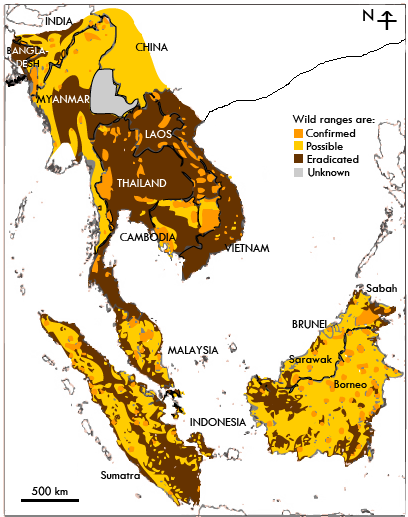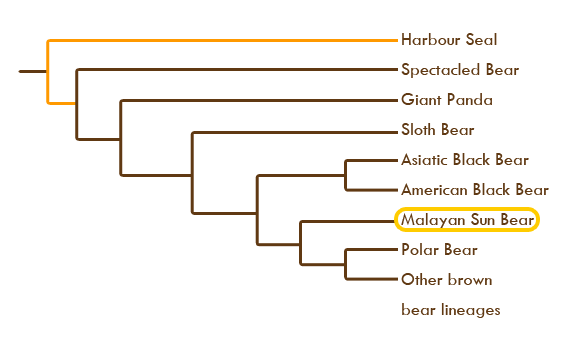The Malayan Sun Bear!
Researchers call it Helarctos malayanus.
Table of Contents
 |
| "Scroll down for more information about me!" Photo credit: Merilyn Tang. |
Huh… What is it?
It looks like this: |
| The Malayan Sun Bear. Photo credit: Merilyn Tang. |
They are the smallest of all bears!
- Stocky build, large paws, short muzzle.
- Fur that is short, smooth, jet-black
- A (maybe present) patch of white/cream/yellow/orange fur on its chest, with a varying but usually U or V-shape
- Tongue that is long, and curly at the end
- Claws that are curved and pointed
- All four legs are turned in while walking.
| Video credit: Merilyn Tang. |
Equinoctial Bear, Bruang, Beruang Madu"basindo nan tenggil" - he who likes to sit high(because sun bears love to climb trees)
TaxonavigationOrder: CarnivoraFamilia: UrsidaeSubfamily: UrsinaeGenus: HelarctosSubspecies: H. malayanus,H. euryspilus
What does it eat?
In its natural habitat, it is an opportunistic omnivore. That means it eats everything it sees - imagine a bear in a supermarket grabbing everything! It would get:- honey
- fruits - e.g. figs, coconuts, bananas
- vegetables - e.g. sweet potatoes
- invertebrates - bees, termites, earthworms, wood lice
- small vertebrates such as rodents, lizards & birds
It's a sun bear's life!
It uses its sensitive nose to smell for food or mates, and uses its long, curved claws to dig in the soil or hollow logs.It makes grunts, snuffles, roars and sometimes short barks if scared.
If threatened, or if it wants better views and smells, it stands on its two hind legs like a human.
Sun bears usually live alone and look for food in the daytime. Using its long claws, it spends almost all its time in the trees - sleeping, eating, avoiding predators, even suntanning! If humans disturb them during the daytime, sun bears will hide and only come out in the night time.


What happens if I see a sun bear?
Sun bears are generally timid, poor-sighted and will avoid attacks if possible.However, do not disturb them. Especially if they are injured or have cubs,they will attack.
Does anything scare the sun bear?
Tigers and reticulated python (Fredriksson, 2005) have been noted as its predators, although it is large enough to avoid being eaten. If it does get attacked, it has loose and wrinkled skin around its neck, so it can turn around and attack predators that bite it on its back!
What is its life history like?
Females are pregnant for 95 days, then give birth to one to two, sometimes three, cubs in dens such as dead, hollowed trees or between the gigantic buttress roots of rainforest trees.
The blind, hairless and helpless cubs have to depend fully on their mothers.
When they are 1.5 years old, they get their complete adult teeth!
They are ready to mate around the age of three, and have lived up to 24 years in captivity.
Where does it live?
It lives in the tropical rainforests of Southeast Asia, and likes climbing trees. Scientists define these rainforests as dense lowland tropical forests, dipterocarp/ lower montane & swamp forests. It can be found up to a range of 2800m above sea level!The Malayan Sun Bear used to be found all over, but have gone extinct in a large part of Southeast Asia. The areas where it has gone extinct are shown in dark brown. Orange parts show its definite range, and yellow regions show where they might be found, but people are unsure.
 |
| Based on a graphic from http://sunbears.wildlifedirect.org/sun-bear-helarctos-malayanus/. Illustration credit: Merilyn Tang. |
Who named it?
Sir Stamford Raffles (yes, the founder of Singapore) first named it Ursus malayanus, meaning "a bear from Malaya".Later on, Sir Thomas Horsfield realized that it was unlike the other bears in America, Europe and Northern Asia. He described it as belonging to a different genus, Helarctos.
The word Helarctos comes from the Greek and Indo-European languages, meaning the Sun (Hela) and bear (*rktos).
|
||
| Sun Bear says, "See my sun!" |
 |
| Illustration credit: Horsfield, 1825 |
Did you know?The animal that Horsfield described in 1825 used to be kept alivein the Royal Menagerie in the Tower of London,and was originally from Borneo.However, this author could not find where this original animal is now preserved;otherwise you might be able to compare this specimen with the bears you find,and see if Horsfield is correct!
How is it unique from other bears in the world?
It is the smallest, most endangered, and yet the least-studied of all the bears!Based on phylogenetic analyses, Malayan Sun Bears are more closely-related to the polar bears than the giant pandas.
 |
| Edited from Talbot & Shields, 1996. Diagram by Merilyn Tang. |
Here is a top-to-bottom comparison:
|
|
Malayan Sun Bears have a long and curly tongue! Used together with its curved claws and protruding lips, these help it to get honey from bees' nests, and termites from termite nests. |
|
In addition, Sun Bears do not hibernate because food in the tropics is available all year round.
How come some sun bears look slightly different from each other?
Each sun bear's chest patch is like a fingerprint - no individuals have the same pattern.However, there are different subspecies, i.e. different kinds within the same species.
| H. malayanus has a reddish-brown muzzle, and its chest markings are white. First described with a bear from Sumatra. |
H. euryspilus has chest markings that are more orange than H. malayanus. It was first described with a bear from Borneo, by Thomas Horsfield in 1825. |
H. anmamiticus has smaller teeth (Meijaard, 2004). It was first described in Annam, Vietnam. |
Why is it important…
To me, or to anybody?
There are fewer and fewer Sun Bears and if this pattern continues, we may not have any wild Sun Bears left for the future. |
| Please save my family and me :( |
Their numbers are decreasing rapidly, because of many reasons:
| Loss of natural habitats The Sun Bears' homes in the tropical rainforest are being cleared of trees, in order to 1) Take the wood for human use (e.g. paper, furniture, houses), 2) Use the land for farming and other agricultural purposes. |
| Exploitation Sun bears are removed from the rainforest because of… 1) Hunting and recreation
2) Domestication as pets
3) Use as exotic meat, or to farm for their bile and gall bladders which in Asian folk medicine
4) Their skins are valuable |
|
||
|
For the other animals and the forest?
Sun Bears eat termites, and termites tend to feed on the wood of trees. The Sun Bears therefore helps to control the numbers of termites so that the trees are able to survive.Sun bears also eat large numbers of fruits, and they indirectly help the plants in the rainforest! After digestion, the sun bears disperse their indigestible seeds so that the plants can continue to survive into the future.
To protect the world's plants and animals, a worldwide organisation called the International Union on the Conservation of Nature and Natural Resources (IUCN) was created. It has a Red List of plants and animals in danger. On this list, the Malayan Sun Bear is listed as Vulnerable (this is the link: __http://www.iucnredlist.org/apps/redlist/details/9760/0__).
All international commercial trade of Malayan Sun Bears, like other Asian bears, is prohibited according to the Convention on International Trade in Endangered Species (CITES) Appendix 1. However, this lacks enforcement.
What can I do to help?
You might be interested to find out more, by following these links.Online webpages dedicated to the Malayan Sun Bear:
| RAFFLES, T. S. 1821. Descriptive catalogue of a zoological collection, made on account of the honourable East India Company, in the island of Sumatra and its vicinity, under the direction of Sir Thomas Stamford Raffles, Lieutenant-Governor of Fort Marlborough; with additional notices illustrative of the natural history of those countries. Transactions of the Linnaean Society of London 13:239–274. |
| HORSFIELD, T. 1825. Description of the Helarctos euryspilus; exhibiting in the bear from the island of Borneo, the type of a subgenus of Ursus. Zoological Journal 2:221–234. Available online: http://www.biodiversitylibrary.org/pdf3/008345300019413.pdf |
| Fitzgerald, C. S., and Krausman, P. R. (2002). Helarctos malayanus. In Mammalian Species, 696: 1-5. American Society of Mammalogists. |
| Fredriksson, G. M. (2005). Predation on Sun Bears by Reticulated Python in East Kalimantan, Indonesian Borneo. In The Raffles Bulletin of Zoology 53 (1): 165:168. National University of Singapore. |
| McLellan, B., and Reiner, D. C. (1994). A Review of Bear Evolution. Bears: Their Biology and Management , Vol. 9, Part 1: A Selection of Papers from the Ninth International Conference on Bear Research and Management, Missoula, Montana, February 23-28, 1992 (1994), pp. 85-96 Published by: __International Association of Bear Research and Management__ Article Stable URL: __http://www.jstor.org.libproxy1.nus.edu.sg/stable/3872687__ |
| Meijaard, E. (2004). Craniometric differences among Malayan Sun Bears (Ursus Malayanus); evolutionary and taxonomic implications. In The Raffles Bulletin of Zoology 52 (2): 665-672. National University of Singapore. |
| Talbot, S. L., and Shields, G. F. (1996). A phylogeny of the bears (Ursidae) inferred from complete sequences of three mito- chondrial genes. In Molecular Phylogenetics and Evolution 5: 567–575. |
What about my community?
- Tell your friends! Sun bears tend to be active at night (especially in human-disturbed areas), so keep an eye and ear out for them!
- Start a project to raise awareness!
- (add in your own)
What if I find a bear…
| How do I know it is this species? |
Check your bear: does it have…* Fur that is short, smooth, jet-black?
|
| What do I do? |
Tell the local authorities. Meanwhile, if you find a cub: its eyes open at 25 days, and will fully see and hear more sharply at 50 days of age. In the first two months, mother bears’ licking will stimulates egestion of waste; zookeepers usually substitute this by sponging. |




